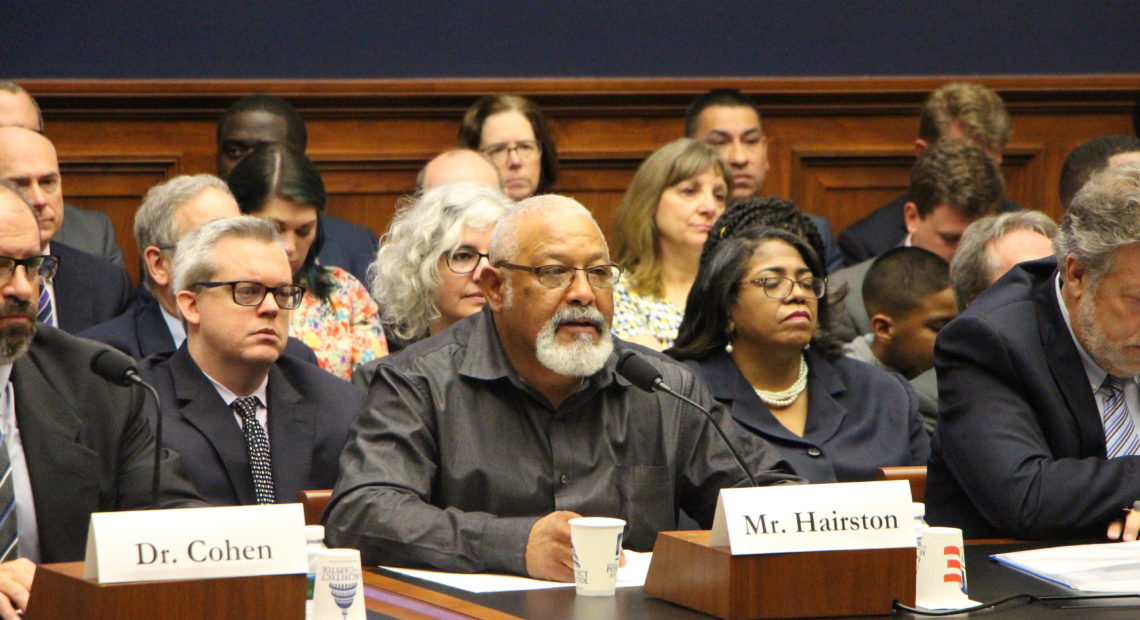
Regulators Resist Call For Action In Response To Black Lung Epidemic
PHOTO: Gary Hairston, a coal miner for 27 years, spoke at the hearing. He has been diagnosed with Progressive Massive Fibrosis, the advanced stage of black lung disease. CREDIT: House Committee on Education and Labor
BY HOWARD BERKES & HUO JINGNAN
The nation’s top coal mine safety regulator told members of Congress Thursday that there’s no need for new regulations, despite an epidemic of advanced black lung disease among coal miners in Appalachia.
Assistant Secretary of Labor David Zatezalo testified before the House Workforce Protections Subcommittee that new coal mine dust rules that took full effect in 2016 should sufficiently limit exposure to the toxic silica dust blamed for the disease outbreak.
“Due to the decades-long latency period between exposure and disease and manifestation, a medically valid study [of the new rules] cannot be completed in the near term,” Zatezalo said.
But he added that his agency “anticipates the study will confirm that dramatic increases in sampling and compliance translate into reduced black lung incidents going forward.”
Zatezalo said sampling of silica dust in coal mines today shows a compliance rate of close to 99 percent, meaning most samples of mine air do not contain excessive levels of the toxic dust, which is said to be more toxic than coal dust.
But a pulmonologist who has spent decades studying the disease provided the results of new studies suggesting the epidemic will not subside.
“The evidence shows that the case numbers are still rising,” said Dr. Robert Cohen, director of the Mining Education and Research Center at the University of Illinois at Chicago.
“We don’t have any evidence that that’s plateauing or that’s stopping,” Dr. Cohen continued, noting that the new 2016 coal mine dust rules don’t directly address silica. “We’d be doing a huge disservice to wait until we have another generation of miners with this disease.”
Cecil Roberts, president of the United Mine Workers of America, was blunt.
“Coal miners don’t have any time,” Roberts told the committee. “They’re dying in West Virginia and they’re dying in Kentucky and they’re dying in Virginia. And they don’t have any more time to wait here.”
Roberts called on Zatezalo and his agency to enact new rules directly regulating silica dust in coal mines and cutting the exposure limit in half, which government researchers have recommended repeatedly since 1974.
The regulatory scheme for silica has not changed in decades. An NPR/PBS Frontline investigation found the federal inspectors measured thousands of excessive silica exposures in the last 30 years even after they required mines to reduce exposure.
A new study from the National Institute for Occupational Safety and Health, or NIOSH, found the same regulatory failure in its review of agency silica sampling and exposure data.
Two other studies of thousands of miner x-rays and tissue samples found higher rates of silica-caused black lung disease in the last decade. Some of the x-rays are from miners who are still working today or who worked recently.
“We can anticipate that there are a group of people who are working right now who we will be having this conversation in about five years from now and ten years from now unless practices change,” said Scott Laney, a NIOSH epidemiologist involved in the studies.
Laney spoke with NPR before the hearing and noted that the silica dust sampling conducted by the mine safety agency only occurs a fraction of the time miners are working. And the sampling misses episodes of high exposures, including the cutting of solid silica-bearing rock, often for months at a time, as mining companies try to reach new coal seams.
“We think that this is probably something that’s happening with more frequency and it’s producing more disease,” Laney said.
Rep. Alma Adams, the chair of the subcommittee, asked Zatezalo why his agency doesn’t adopt the same silica exposure limit that applies to all industries except mining. Those industries are regulated by the Occupational Safety and Health Administration, or OSHA, which adopted in 2016 a silica limit twice as restrictive as the one used for mining.
At the time, Zatezalo’s predecessor at the Mine Safety and Health Administration, or MSHA, said he would follow OSHA’s lead but ran out of time.
Zatezalo said the average silica dust sample in coal mines already beats the tougher OSHA limit.
That means there are still exposures that exceed the OSHA standard.
“It’s just absolutely nonsensical that that doesn’t apply to miners as well,” said Dr. Cohen. “Their workers are exposed to the same dust so I think that has to be done.”
The hearing also included Gary Hairston, a coal miner for 27 years who has been diagnosed with Progressive Massive Fibrosis, the advanced stage of black lung disease. He was just 48, he said, when he began to have trouble breathing and working.
“I couldn’t even play with my grand-kids,” Hairston said, tears forming in his eyes. “I never did think at this young age that I wouldn’t be able to take care of my family.”
9(MDAyOTk4OTc0MDEyNzcxNDIzMTZjM2E3Zg004))















